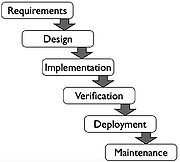Waterfall vs. Pull Processes
There are many different methodologies of project management, all of them are defined by different principles and processes. A traditional, sequential methodology, is the Waterfall model. Within this model, the tasks of the project plan are sequenced and conducted in a linear way, one task must be completed before the next one begins - the process is smooth and continuous, like a waterfall. Therefore, this model is one of the simplest methods. However, the pull process-based methodologies are used to create the whole project plan more efficient and effective, it was created to eliminate confounding factors within the project, but it is more complex due to the consideration of many influences. This article provides an introduction to both methodologies, a comparison with pros and cons and a guidance how to select the right methodology for the practical usage.
Contents |
Importance for Project Management
Waterfall Process
The waterfall process...
Pros
Cons
Pull Process
By adding out of scope functionalities, you can expect that it will impact negatively your project triple constraint. If you make more work than required at a certain time, it will be pilled in waiting to be expedited to the next step. You should also avoid here to execute project management activities in a batch. Indeed if there is any product change request then you would end up with obsolescence and therefore waste.
